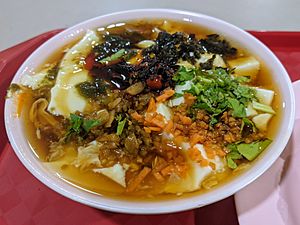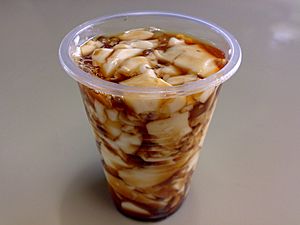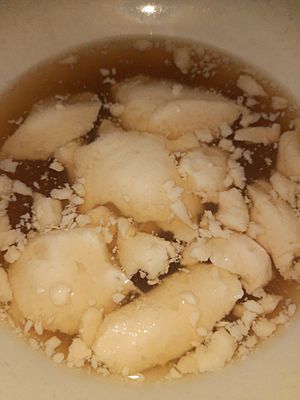Douhua facts for kids

Douhua in sugar syrup
|
|
| Alternative names | Doufuhua, doufunao, laodoufu, tofu pudding, soybean pudding |
|---|---|
| Type | Snack |
| Place of origin | China |
| Region or state | East Asia and Southeast Asia |
| Main ingredients | Tofu |
| tofu pudding | |||||||||||||||||||||
|---|---|---|---|---|---|---|---|---|---|---|---|---|---|---|---|---|---|---|---|---|---|
| Chinese | 豆腐花 | ||||||||||||||||||||
| Literal meaning | bean curd flower | ||||||||||||||||||||
|
|||||||||||||||||||||
| Alternative Chinese name | |||||||||||||||||||||
| Traditional Chinese | 豆花 | ||||||||||||||||||||
| Simplified Chinese | 豆花 | ||||||||||||||||||||
|
|||||||||||||||||||||
| Second alternative Chinese name | |||||||||||||||||||||
| Traditional Chinese | 豆腐腦 | ||||||||||||||||||||
| Simplified Chinese | 豆腐脑 | ||||||||||||||||||||
|
|||||||||||||||||||||
Douhua (Chinese: 豆花; pinyin: dòuhuā; Pe̍h-ōe-jī: tāu-hoe) is a yummy Chinese snack. It's made from very soft tofu. People also call it doufuhua (Chinese: 豆腐花; pinyin: dòufuhuā), tofu pudding, or soybean pudding. In northern China, it's sometimes called tofu brains (Chinese: 豆腐脑; pinyin: dòufunǎo) because it's so soft. Douhua can be sweet or savory, depending on where you are!
Contents
History of Douhua
Tofu first came from ancient China. This was during the Han dynasty a very long time ago. A prince named Liu An wanted to create something special. He hoped to make a magic pill that would help people live forever.
He didn't make a magic pill. But he mixed soybeans and a special ingredient called bittern. This mix made soft, white tofu. It tasted amazing! People called it "tofu brains" because it was so smooth. Soon, it became a popular snack. Over 2,000 years, douhua spread all over China.
During a big war, the Second Sino-Japanese War, a man named Liu Xilu had a famous douhua restaurant. He learned how to make beancurd from others. Then he made his own secret recipe. This made the taste even better!
Different Names for Douhua
Douhua has many names across China and other countries.
- In Taiwan, Sichuan, and other southern areas, it's often called Douhua. Sweet versions are common here.
- In southern China, Hong Kong, and Malaysia, it's known as Doufuhua.
- Northern China, Hubei, and Shanghai often call it Doufunao. This means "tofu brains."
- In Tianjin, a city in China, it's called Laodoufu, meaning "old tofu."
- Some places like Taizhou, Zhejiang call it Doufusheng.
- In Hubei, spicy douhua is sometimes called "silk tofu."
How Douhua is Eaten
Douhua can be eaten in three main ways: savory, spicy, or sweet.
Savory Douhua
In northern China, people often eat douhua with soy sauce. This makes it taste savory. They might add chopped meat, Chinese pickles, or mushrooms. Coastal cities sometimes add seaweed and small shrimp. You can often find savory douhua at breakfast stands. People eat it with eggs or fried dough sticks called youtiao.
Spicy Douhua
In Sichuan and Shaanxi, douhua is made spicy. They add chili oil and Sichuan pepper to it. Street vendors often sell it from carts. They offer different toppings like chili oil, soy sauce, green onions, and nuts. There's a famous Sichuan dish called spicy tofu fish. It uses douhua as a key ingredient.
Sweet Douhua
In southern China, douhua is usually sweet. It's served with sweet ginger syrup or clear syrup. In summer, people eat it cold to cool down. In winter, they add hot sweet water and beans to stay warm. People in Hong Kong sometimes add sesame paste.
Sweet douhua is a popular dessert in southern China. It's often part of a meal called yum cha.
Douhua in Southeast Asia
In Southeast Asia, douhua is almost always sweet. But the toppings can be very different!
Filipino Douhua (Taho)
In the Philippines, douhua is called taho. It's fresh, soft tofu served with sweet brown syrup and sago pearls. Vendors often sell it in the mornings. They go door-to-door or sell it in public places. Sometimes, taho is served with different syrups like sugarcane, ube, or strawberry.
Indonesian Douhua (Kembang Tahu)
In Indonesia, it's known as Kembang tahu or Tahwa. Wedang Tahu is another name, meaning "hot tofu drink." It's usually sold by street vendors. It's served warm or cold. It comes with palm sugar syrup flavored with pandan leaves and ginger.
Malaysian and Singaporean Douhua
In Malaysia and Singapore, it's called tau hua or tau huay. The Cantonese name, tau fu fa, is also common. It's usually served with clear sweet syrup. Sometimes, ginkgo seeds are added to the syrup. It can also be served with palm syrup called Gula Melaka.
Thai Douhua (Taohuai)
In Thailand, it's called taohuai. It's often served cold with milk and fruit salad. This is known as taohuai nom sot. Or it can be served hot with ginger syrup, called taohuai nam khing.
Vietnamese Douhua (Tàu hủ)
In Vietnam, it has names like tàu hủ nước đường or tào phớ. How it's served depends on the region:
- Northern Vietnam — Served with sugary water that smells like jasmine. It's warm in winter and cold with ice in summer.
- Central Vietnam — Cooked with spicy ginger and sugar. The douhua pieces are very soft.
- Southern Vietnam — Served warm with lychee and coconut water. Ginger is an option. The douhua pieces are a bit firmer here.
Packaged Douhua
You can also find douhua in plastic containers. These are sold in Asian supermarkets in North America.
How Douhua is Made
Like all tofu, douhua needs a special ingredient to make it firm. This ingredient is called a coagulant. For douhua, gluconolactone is often used. It helps make the douhua extra smooth.
Douhua in Pop Culture
Tofu pudding was shown on the Netflix TV series, Street Food. It was featured in the episode about Chiayi, Taiwan.
See also
 In Spanish: Douhua para niños
In Spanish: Douhua para niños







